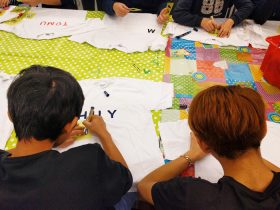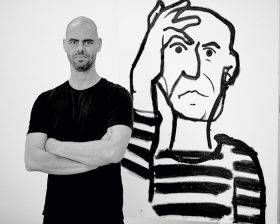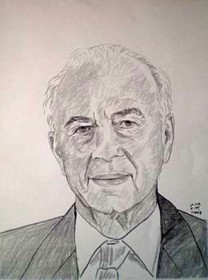Workshops for young refugees

Whether in Hebrew, Arabic, or German, there are lots of ways to write one’s name; photo: private
What’s written in a Jewish marriage contract? As a minority, how do you secure your civil rights? And why is Hanukkah celebrated for eight days? My work as a guide at the Jewish Museum isabout how to coax stories from objects on display — but also about language. The first thing I did when I began working here about four years ago was to look up how to say “ruminants with cloven hooves” in French. You need to have this phrase at the ready if you want to explain Jewish dietary laws to a group of French museum visitors. My French didn’t help much, however, when I led the first workshops in August of 2016 for Welcome Classes. → continue reading
An Interview with Eran Shakine
Today, on 27 October 2016 at 7 pm, our exhibition “A Muslim, a Christian, and a Jew” is opening with Eran Shakine in attendance. In the run-up to the opening, Gregor H. Lersch spoke with the Israeli artist about religion, art, and his sources of inspiration.

Eran Shakine; photo: Shay Kedem
Gregor H. Lersch: What does “A Muslim, a Christian and a Jew” (MCJ) show?
Eran Shakine: “A Muslim, a Christian and a Jew…” sounds like the beginning of a joke. But that is just to get your attention.
The show is an installation consisting of 40 paintings, drawings, and three metal cut-out sculptures.
The three similar figures, their religious background unidentifiable, create situations by means of a vivid and comical body language. In every drawing they witness and experience major events in history or philosophy, or meet important figures like Moses, Buddha or Nelson Mandela. The three heroes, dressed as 19th century gentlemen, help each other in their journey to find the love of God.
Here, there are no stereotypes, no one is the laughingstock, everyone is the same; we see three human beings who explore life, nature, culture and philosophy, out of shared curiosity, without trying to prove each other wrong.
Why did you start to work on MCJ? → continue reading
Remembering 4 November 1995
Twenty years ago today, 4 November 1995, Israel prime minister, Yitzhak Rabin, was assassinated following a peace rally in central Tel Aviv. Mirjam Wenzel was there.
“It was a mild evening at Kikar Malchei Yisrael (Kings of Israel Square, now Yitzhak Rabin Square) in the middle of Tel Aviv, where throngs of people had gathered under signs of shalom achshav (peace now) to show their support for Rabin and Shimon Peres and their push for peace. The national religious movement had grown more hostile towards the government in recent weeks, and the media had been reporting its demonstrations with posters of Rabin in a SS uniform. No one could imagine, at least not within my circles, that this movement could turn deadly. From the Tel Aviv office of the Friedrich Ebert Foundation, where I had a semester internship, the Oslo Accords were viewed as a political and economic fact. → continue reading


